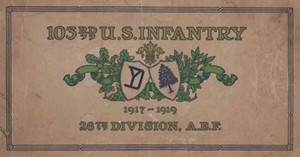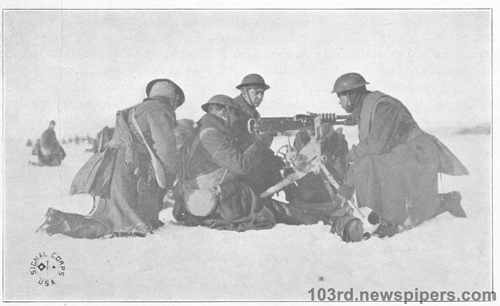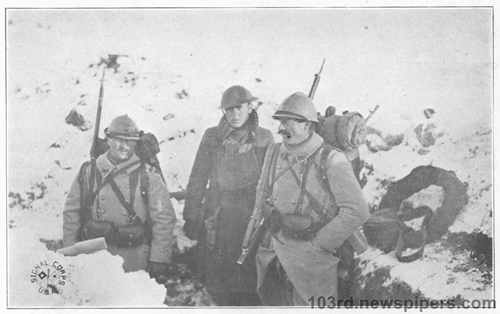
of the 26th Division of the U.S. Army
during World War I
 | The History of the 103rd Regiment of the 26th Division of the U.S. Army during World War I |
| Table of Contents | ||
|
CHAPTER III IN TRAINING PIIYSICALLY the area chosen for the regiment’s training was a good one; this in spite of the rainy season and the mud which started at the timc of the rogiment's arrival and lasted until January; for with its broad fields and the ground allotted for drill, there was ample room both for closc—order drill and inanocuvres. The regiment settled, the period of instruction and training commenced in earnest, with ari)average of six hours’ drill every day except Saturday and Sun- day, Saturday mornings were given over to inspection, Saturday afternoons and Sundays to rcst and recreation, though in the last month, January, d1·ill was carried on Saturday afternoons and Sundays. The companies perfected their organization by platoons, and within the pla- toons the smaller groups were organized, — automatic ridemen, bombers, ride grenadiers, riflemen. The Cliauclnat automatic rifle (French) was issued. In addition to the close-order drill, physical cxercise, bayonet-fighting, and gas drill, which every man had, there was the training of the specialists.  Shortly after the regiment arrived in the area, its tutelage in trench warfare
was taken up by a battalion of the 162nd French Infantry, Colonel Bertrand
commanding, Major (Commandant) Roy in command of the battalion which
was stationed at Pargny, about seven kilometers distant from Iliffol. Part of
the battalion was assigned to instruct the troops at Villouxel (this instruction
was carried on at Pargny) the remainder to the troops at Liffol. For those who
were stationed at Liffol, the instruction was given on the hills beyond Freville.
Oliieers and men were taught the use and operation of the automatic rifle, rifle
grenades, bombs, and also thc manceuvring of combat groups, platoons, com-
panies, and battalions in attack, according to the principles of French tactics.
Much of this work was laid out in the "Manui1l for Platoon Chiefs," which
was the standard manual for platoon leaders in thc French Army, — a very
valuable book, and its value led to its translation into English and issuance
to our officers. In all of the work thc men took a keen interest and learned
quickly.
At the same time that the infantry was receiving its instruction, the Machinc·
Gun Battalion and the 103rd Machine-Gun Company were also learning much
from the French.
In addition to the practical instruction several lectures were given by French
oH*iccrs to our own. There were also attached to us to help and act as advisers,
two French onieers, Captains Colier and Lemeitour.
It must be borne in mind that this instruction by the French was in addition
to our own program which included mameuvring under the American system.
New that it is over, one cannot help recalling the words of the Brigade Com-
mander at an ofiiccrs’ lecture or conference at Liffol in January when he said
in substance, "The war will be won in thc open; the Boche is in the trenches now
and has been for four years. Vile have got to be able to drive him out and that is
why this French instruction is valuable; but remember we are going to get him
out into the open and then all the old and fixed principles of our school of warfare
will come into play." How true this was the expe1·i<·nt·os of this regiment, from
Chateau-Thi<·rry to the end proved.
Possibly some were a little hasty, :1 little loo impetuous during those first
months of training, but on tho whole thc lessons learned were valuable not alone
from this or that- specific thing which was taught, but from the mingling of our
onicers and men with thc French; they learned many a trick and stunt which
would be of value in the months to come,
It may not be history, but the writer makes record here of an incident which
to him was of deep signihcanve. Shortly after thc battalion of Colonel Bertrandls
regiment had taken up the inslrul·tion of the 103rd, all of the oficers of the 103rd
were requested to atteml a de1nr>nstralion at Pargny. This included bombing
work, automatic rifle, machine guns, rifle grenades, and a manoeuvre showing
different attack formations A all by French officers and soldiers; our own oHicers
were at liberty to ask questions and take notes. The exercises lasted until nearly
dark. After they were over, our odicers were asked by the French officers to
come up to the battalion mess. It was all done in a very casual sort of a way.
One entered a large room in the center of which was a long table fairly ablaze
with candles. The glasses reflected the light; there were plates of sweet cakes;
champagne was liberally laid out on the table.
Shortly after the regiment arrived in the area, its tutelage in trench warfare
was taken up by a battalion of the 162nd French Infantry, Colonel Bertrand
commanding, Major (Commandant) Roy in command of the battalion which
was stationed at Pargny, about seven kilometers distant from Iliffol. Part of
the battalion was assigned to instruct the troops at Villouxel (this instruction
was carried on at Pargny) the remainder to the troops at Liffol. For those who
were stationed at Liffol, the instruction was given on the hills beyond Freville.
Oliieers and men were taught the use and operation of the automatic rifle, rifle
grenades, bombs, and also thc manceuvring of combat groups, platoons, com-
panies, and battalions in attack, according to the principles of French tactics.
Much of this work was laid out in the "Manui1l for Platoon Chiefs," which
was the standard manual for platoon leaders in thc French Army, — a very
valuable book, and its value led to its translation into English and issuance
to our officers. In all of the work thc men took a keen interest and learned
quickly.
At the same time that the infantry was receiving its instruction, the Machinc·
Gun Battalion and the 103rd Machine-Gun Company were also learning much
from the French.
In addition to the practical instruction several lectures were given by French
oH*iccrs to our own. There were also attached to us to help and act as advisers,
two French onieers, Captains Colier and Lemeitour.
It must be borne in mind that this instruction by the French was in addition
to our own program which included mameuvring under the American system.
New that it is over, one cannot help recalling the words of the Brigade Com-
mander at an ofiiccrs’ lecture or conference at Liffol in January when he said
in substance, "The war will be won in thc open; the Boche is in the trenches now
and has been for four years. Vile have got to be able to drive him out and that is
why this French instruction is valuable; but remember we are going to get him
out into the open and then all the old and fixed principles of our school of warfare
will come into play." How true this was the expe1·i<·nt·os of this regiment, from
Chateau-Thi<·rry to the end proved.
Possibly some were a little hasty, :1 little loo impetuous during those first
months of training, but on tho whole thc lessons learned were valuable not alone
from this or that- specific thing which was taught, but from the mingling of our
onicers and men with thc French; they learned many a trick and stunt which
would be of value in the months to come,
It may not be history, but the writer makes record here of an incident which
to him was of deep signihcanve. Shortly after thc battalion of Colonel Bertrandls
regiment had taken up the inslrul·tion of the 103rd, all of the oficers of the 103rd
were requested to atteml a de1nr>nstralion at Pargny. This included bombing
work, automatic rifle, machine guns, rifle grenades, and a manoeuvre showing
different attack formations A all by French officers and soldiers; our own oHicers
were at liberty to ask questions and take notes. The exercises lasted until nearly
dark. After they were over, our odicers were asked by the French officers to
come up to the battalion mess. It was all done in a very casual sort of a way.
One entered a large room in the center of which was a long table fairly ablaze
with candles. The glasses reflected the light; there were plates of sweet cakes;
champagne was liberally laid out on the table.
 At the head of the table were
General Cole, Colonel Bertrand, Colonel Hume, Cominandant Roy, and on
either side the oihccrs, French and American, mingled with the best of fellow-
ship. At the word given by Colonel Bertrand, orderlies filled the glasses and
Colonel Bertrand proposed it toast to the 103rd. Very simply he expressed his
pleasure at being able to help and instruct. llc welcomed the oHicers and regi-
ment as comrades in arms. lt was all done as a French olhcer and gentleman
knows how to do such things, and left a happy memory with those who were
there. Litfol had welcomed and received the regiment to its homes. Colonel
Bertrand had extended the hand of fellowship and welcome to his camp fires.
We were in truth allies. The above incident served as an introduction to the
exchange of courtesies which continued between the 103rd Infantry and the 162nd,
The instruction of the regiment was not confined, however, to the tactical
side only. At Noneourt, on a plateau to the southeast of Neufchateau and about
twelve kilometers from Liffol, a system of trenches was laid out and completed
by the infantry regiments of the division. This work was done under the super-
vision of the French, the American regiments and battalions within the regiments
working in rotation. Nor was this easy work, for the ground was diflicult with
rock and ledges near the surface. When completed, the subsection of N oncourt,
called Quartier cle la Sapiniere, comprised such a system as an infantry battalion
At the head of the table were
General Cole, Colonel Bertrand, Colonel Hume, Cominandant Roy, and on
either side the oihccrs, French and American, mingled with the best of fellow-
ship. At the word given by Colonel Bertrand, orderlies filled the glasses and
Colonel Bertrand proposed it toast to the 103rd. Very simply he expressed his
pleasure at being able to help and instruct. llc welcomed the oHicers and regi-
ment as comrades in arms. lt was all done as a French olhcer and gentleman
knows how to do such things, and left a happy memory with those who were
there. Litfol had welcomed and received the regiment to its homes. Colonel
Bertrand had extended the hand of fellowship and welcome to his camp fires.
We were in truth allies. The above incident served as an introduction to the
exchange of courtesies which continued between the 103rd Infantry and the 162nd,
The instruction of the regiment was not confined, however, to the tactical
side only. At Noneourt, on a plateau to the southeast of Neufchateau and about
twelve kilometers from Liffol, a system of trenches was laid out and completed
by the infantry regiments of the division. This work was done under the super-
vision of the French, the American regiments and battalions within the regiments
working in rotation. Nor was this easy work, for the ground was diflicult with
rock and ledges near the surface. When completed, the subsection of N oncourt,
called Quartier cle la Sapiniere, comprised such a system as an infantry battalion
|
||
| Original Version of Page |